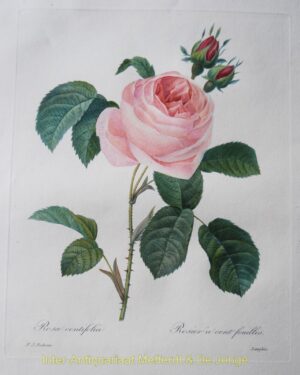“Rosa Centifolia – Rosier a cent Feuilles”. Stipple engraving made by Langlois 1827-1833 for “Choix des plus belles fleurs” after the design of Pierre-Joseph Redouté, printed in colours and finished by hand. Size (plate): 27 x 21,5 cm (paper: 48 x 32,4 cm).
Pierre-Joseph Redouté (1759-1840) was one of the world’s great flower painters. Born into a family that had been painters for at least two generations, Redouté went to Paris in 1782 with his brother where they worked as scene painters for the Théâtre Italien. Redouté painted flowers in his spare time. The search for subjects led him to the Jardin du Roi and eventually to Gerard van Spaendonck who made him an assistant. While at the royal gardens, Redouté came to know Charles-Louis L’Heritier, an amateur botanist and writer of independent means. He gave Redouté a full time job as an illustrator, instructing him in plant anatomy.
Redouté’s scientific understanding of plants contributed greatly to the clarity of his depictions. But it was Redouté’s work in stipple engraving and colour printing that was to be of the greatest importance. Stippling and the application of two or three colour inks to one plate were engraving innovations that Redouté brought to French printmaking, and these were brought to perfection in his three great works: Les Liliacees (1802-1816), Les Roses (1817-1824) and the work from which this image comes Choix des plus belles fleurs… et … des plus belles fruits which was published in 36 parts with 144 plates between 1827 and 1833.
The prints were usually sent to subscribers as separate quires, which were bound into a book at a later stage, but not always. Complete books are therefore rare and such a complete book is, as far as we know, not present in the Netherlands.
Redouté was a court painter to Marie Antoinette and later Empress Joséphine de Beauharnais (the first wife of Napoleon) who was famous for her gardens in Chateaux Malmaison with over 250 varieties of roses. Redouté became Artiste-en-residence at Malmaison.
After Empress Joséphine’s death, Redouté was less prosperous. He became a drawing teacher at the Musée d’Histoire Naturelle in 1822 and knight of the Légion d’Honneur in 1825. Redouté is best known for his roses and lilies, but also his “Choix des plus belles Fleurs”, published for purely aesthetic reasons, is widely praised.
Price: SOLD





